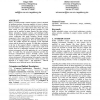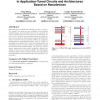CF
2004
ACM
14 years 6 months ago
2004
ACM
This paper looks at the evolution of the "Memory Wall" problem over the past decade. It begins by reviewing the short Computer Architecture News note that coined the phr...
CF
2004
ACM
14 years 6 months ago
2004
ACM
In this paper we present a novel methodology for partial (re-)configuration that can be used for most bitstream configured hardware (HW). In particular low priced and not for part...
CF
2004
ACM
14 years 6 months ago
2004
ACM
CF
2004
ACM
14 years 6 months ago
2004
ACM
Off-chip memory accesses are a major source of power consumption in embedded processors. In order to reduce the amount of traffic between the processor and the off-chip memory as ...
CF
2004
ACM
14 years 6 months ago
2004
ACM
There is a sustained trend to embed computer systems in all kinds of intelligent products. Increasing emphasis is given to enhance the functionality of such systems beyond the pro...
CF
2004
ACM
14 years 7 months ago
2004
ACM
Nanoelectronics research has primarily focused on devices. By contrast, not much has been published on innovations at higher layers: we know little about how to construct circuits...
CF
2004
ACM
14 years 7 months ago
2004
ACM
New applications and standards are first conceived only for functional correctness and without concerns for the target architecture. The next challenge is to map them onto an arch...
CF
2004
ACM
14 years 7 months ago
2004
ACM
Ì × Ô Ô Ö Ú ÐÙ Ø × Ø « Ø Ó Ò ÙØÓ¹ØÙÒ Ò Ð ØÝ Û Ø Ø Ù× Ö³× ÒÓÛÐ ÓÖ ÒÙÑ Ö Ð ×Ó ØÛ Ö º Ï ÔÖÓ¹ ÔÓ× Ò Û ×Ó ØÛ Ö Ö Ø �...
CF
2004
ACM
14 years 7 months ago
2004
ACM
This paper discusses fault-tolerant techniques for SRAM-based FPGAs. These techniques can be based on circuit level modifications, with obvious modifications in the programmable a...
CF
2004
ACM
14 years 7 months ago
2004
ACM
Aimed to provide computation ubiquitously, pervasive computing is perceived as a means to provide a user the transparency of anywhere, anyplace, anytime computing. Pervasive compu...



